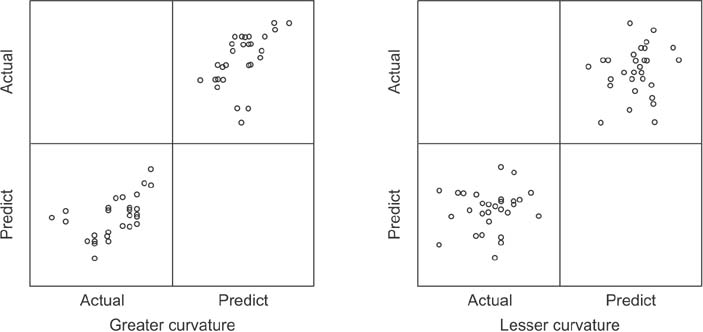J Gastric Cancer.
2016 Dec;16(4):247-253. 10.5230/jgc.2016.16.4.247.
Anthropometric Study of the Stomach
- Affiliations
-
- 1Department of Surgery, Seoul National University College of Medicine, Seoul, Korea. hkyang@snu.ac.kr
- 2Cancer Research Institute, Seoul National University College of Medicine, Seoul, Korea.
- 3Department of Pathology, Seoul National University College of Medicine, Seoul, Korea.
- KMID: 2389850
- DOI: http://doi.org/10.5230/jgc.2016.16.4.247
Abstract
- PURPOSE
The aim of this study was to establish an anthropometric reference of the stomach for gastric cancer surgery and a modeling formula to predict stomach length.
MATERIALS AND METHODS
Data were retrieved for 851 patients who underwent total gastrectomy at the Seoul National University Hospital between 2008 and 2013. Clinicopathological data and measurements from a formalin-fixed specimen were reviewed. The lengths (cm) of the greater curvature (GC) and lesser curvature (LC) were measured. Anthropometric data of the stomach were compared according to age, body weight, height (cm), and body mass index. To predict stomach length, two multiple regression analyses were performed.
RESULTS
The mean lengths of the GC and LC were 22.2±3.1 cm and 16.3±2.6 cm, respectively. The men's GC length was significantly greater than the women's (22.4±3.1 cm vs. 21.2±2.9 cm, P=0.003). Patients aged >70 years showed significantly longer LC than those aged <50 years (16.9±2.9 cm vs. 15.9±2.4 cm, P=0.002). Patients with body weights >70 kg showed significantly longer GC than those with body weights <55 kg (23.0±2.9 cm vs. 21.4±3.2cm, P<0.001). In the predicted models, 4.11% of the GC was accounted for by age and weight; and 4.94% of the LC, by age, sex, height, and weight.
CONCLUSIONS
Sex, age, height, and body weight were associated with the length of the LC, while sex and body weight were the only factors that were associated with the length of the GC. However, the prediction model was not sufficiently strong.
Keyword
Figure
Reference
-
1. Japanese Gastric Cancer Association. Japanese classification of gastric carcinoma: 3rd English edition. Gastric Cancer. 2011; 14:101–112.2. Cox AJ. Variations in size of the human stomach. Cal West Med. 1945; 63:267–268.3. Katai H, Sano T, Fukagawa T, Shinohara H, Sasako M. Prospective study of proximal gastrectomy for early gastric cancer in the upper third of the stomach. Br J Surg. 2003; 90:850–853.4. Harrison LE, Karpeh MS, Brennan MF. Total gastrectomy is not necessary for proximal gastric cancer. Surgery. 1998; 123:127–130.5. Palmer WL, Kirsner JB, Ricketts WE, Maimon SN, Dashiell GF. A review of the literature from July 1945 to July 1946. Arch Intern Med (Chic). 1947; 80:89–142.6. Goldsmith HS, Akiyama H. A comparative study of Japanese and American gastric dimensions. Ann Surg. 1979; 190:690–693.7. Lee HJ, Yang HK, Ahn YO. Gastric cancer in Korea. Gastric Cancer. 2002; 5:177–182.8. Shiraishi N, Yasuda K, Kitano S. Laparoscopic gastrectomy with lymph node dissection for gastric cancer. Gastric Cancer. 2006; 9:167–176.9. Kim HH, Hyung WJ, Cho GS, Kim MC, Han SU, Kim W, et al. Morbidity and mortality of laparoscopic gastrectomy versus open gastrectomy for gastric cancer: an interim report--a phase III multicenter, prospective, randomized Trial (KLASS Trial). Ann Surg. 2010; 251:417–420.10. Washington K. 7th edition of the AJCC cancer staging manual: stomach. Ann Surg Oncol. 2010; 17:3077–3079.11. Csendes A, Burgos AM. Size, volume and weight of the stomach in patients with morbid obesity compared to controls. Obes Surg. 2005; 15:1133–1136.12. Hwang TS, Kang HS, Cho BP. A morphometric study on the changes in the size of human oviduct and ovary after immersion in formalin. Korean J Phys Anthropol. 1994; 7:157–162.13. Csendes A, Amdrup E, Parada M. A peroperative technique for determining the extent of gastrectomy. Surg Gynecol Obstet. 1979; 149:81–83.




